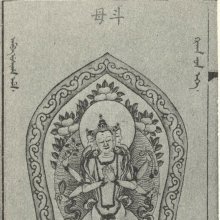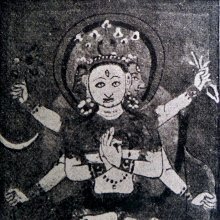Grahamatrika, Grahamātṛkā: 5 definitions
Introduction:
Grahamatrika means something in Buddhism, Pali, Hinduism, Sanskrit. If you want to know the exact meaning, history, etymology or English translation of this term then check out the descriptions on this page. Add your comment or reference to a book if you want to contribute to this summary article.
The Sanskrit term Grahamātṛkā can be transliterated into English as Grahamatrka or Grahamatrika, using the IAST transliteration scheme (?).
Images (photo gallery)
In Buddhism
Tibetan Buddhism (Vajrayana or tantric Buddhism)
Source: archive.org: The Indian Buddhist IconographyGrahamātṛkā (ग्रहमातृका) refers to one of the various emanations of Vairocana, as mentioned in the 12th century Dharmakośasaṃgraha (a work dealing with iconography of Buddhist deities) written by Amṛtānanda.—Her Mudrā is the dharmacakra; her Āsana is the vajraparyahka; she has three faces and six arms.
Grahamātṛkā has been described in the Dharmakośasaṃgraha in the following words:
“Grahamātṛkā has three faces of white, yellow and red colour, and six-arms, displaying the dharmacakra-mudrā (in the principal pair of hands) and carrying the vajra and the arrow in the two right hands, and in the two left the lotus and the bow She sits in the vajrāsana on a lotus of a thousand petals”

Tibetan Buddhism includes schools such as Nyingma, Kadampa, Kagyu and Gelug. Their primary canon of literature is divided in two broad categories: The Kangyur, which consists of Buddha’s words, and the Tengyur, which includes commentaries from various sources. Esotericism and tantra techniques (vajrayāna) are collected indepently.
General definition (in Buddhism)
Source: Cambridge Digital Library: Pañcarakṣā, SaptavāraGrahamātṛkā (ग्रहमातृका) refers to the last of “seven days” (saptavāra) classified as a dhāraṇī according to a 17th-century Sanskrit manuscript from Nepal .—This collection associates each dhāraṇī with a specific day of the week, a tradition going back to at least the sixteenth century in Nepal.
Languages of India and abroad
Sanskrit dictionary
Source: Cologne Digital Sanskrit Dictionaries: Monier-Williams Sanskrit-English DictionaryGrahamātṛkā (ग्रहमातृका):—[=graha-mātṛkā] [from graha > grah] f. Name of a Buddh. goddess.
[Sanskrit to German]
Sanskrit, also spelled संस्कृतम् (saṃskṛtam), is an ancient language of India commonly seen as the grandmother of the Indo-European language family (even English!). Closely allied with Prakrit and Pali, Sanskrit is more exhaustive in both grammar and terms and has the most extensive collection of literature in the world, greatly surpassing its sister-languages Greek and Latin.
See also (Relevant definitions)
Partial matches: Matrika, Graha.
Full-text: Saptavara.
Relevant text
Search found 1 books and stories containing Grahamatrika, Grahamātṛkā, Grahamatrka, Graha-matrika, Graha-mātṛkā, Graha-matrka; (plurals include: Grahamatrikas, Grahamātṛkās, Grahamatrkas, matrikas, mātṛkās, matrkas). You can also click to the full overview containing English textual excerpts. Below are direct links for the most relevant articles:
The Indian Buddhist Iconography (by Benoytosh Bhattachacharyya)
Related products

